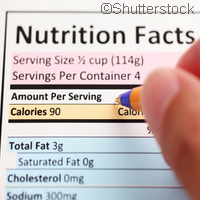Nutrition labelling: not as effective as you might think
Consumers use nutrition labels to make informed decisions about eating the 'right' foods for better health. But new research from Europe shows how there are limitations on how these labels can be used in real-life situations. The results are an outcome of the FLABEL ('Food labelling to advance better education for life ') project, which has clinched almost EUR 2.9 million in funding under the 'Food, agriculture and fisheries, and biotechnology' (European Knowledge Based Bio-Economy or KBBE) Theme of the EU's Seventh Framework Programme (FP7). The findings were presented by FLABEL scientific advisor Professor Klaus G. Grunert in a recent webinar. The good news is that consumers can understand the information found on nutrition labels and use it to make healthful choices. Even information about vital nutrients, including fat, saturated fat, sugar and salt, and energy for a range of products is understood and used properly by most consumers. It should also be noted that most consumers can also rank foods based on their level of healthfulness. The situation goes awry when lack of motivation and attention build barriers, making it difficult for consumers to choose foods based on nutrition labelling. 'Consumers need to be motivated to engage with nutrition information - for instance, by having a health goal - in order to pay attention to nutrition labels,' Professor Grunert says. The impact of nutrition labels on the healthfulness of food choices is diminished because of a lack of attention. For the purposes of this study, the FLABEL team constructed a mock grocery store experiment, where they tracked the eye movements of shoppers as they selected foods for their shopping baskets. Based on the information they collected, the team found that average attention to nutrition labels was between only 25 and 100 milliseconds. This is not enough time for consumers to process the information. When it comes to motivation, while consumers can pay more attention to nutrition information by being encouraged to look at nutrition labels for longer times, what could potentially help is to provide them with information on key nutrients and energy on the front of the pack in a consistent manner. 'Complementing this information with a health logo can also increase attention to, and use of, the information, especially when the consumer is under time pressure,' says Professor Grunert, who is the founder and the director of the Centre for Research on Customer Relations in the Food Sector (MAPP) at Aarhus University in Denmark. 'The use of colour-coding can increase attention and use in certain situations, although the effects are not strong.' Consumers who participated in the FLABEL project noted they prefer and would opt to use more complex labels that provide complete information. The FLABEL results also indicate that 'liking' depends on consumers' previous exposure, or familiarity, with the label. The FLABEL team found that the presence of nutrition information on food labels in Europe is very high. More than 37 000 products across 5 product categories in all EU Member States, plus Turkey, were evaluated in this study. Overall, 85% of food products had nutrition information on the back of the pack, and 48% had nutrition information on the front of the pack. The product categories were biscuits, breakfast cereals, chilled pre-packed ready meals, carbonated soft drinks and yogurts. The FLABEL consortium consists of experts from Belgium, Denmark, Germany, Greece, the Netherlands, Poland, Turkey and the United Kingdom.For more information, please visit:FLABEL:http://www.flabel.org/en/Centre for Research on Customer Relations in the Food Sector (MAPP):http://www.asb.dk/forskning/forskningscentreoggrupper/forskningscentre/mapp/
Countries
Belgium, Germany, Denmark, Greece, Netherlands, Poland, Türkiye, United Kingdom



